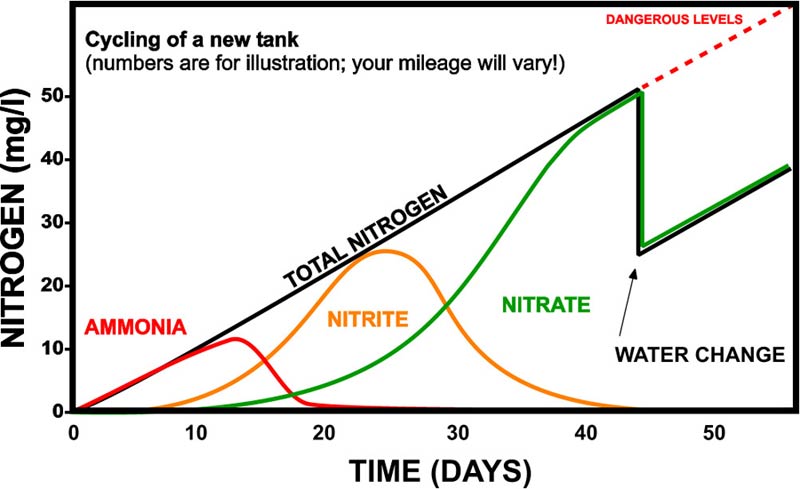Ammonia in ponds and aquariums is a common problem. Ammonia stress and poisoning is often the number one cause of fish illness and deaths when setting up new aquariums, small ponds and quarantine tanks. This is often referred to as ‘New Tank Syndrome’. It is not usually as common a problem in new larger ponds because the ammonia is diluted in the larger volume of water and doesn’t reach toxic levels. Ammonia stress can also occur in well established ponds for a variety of different reasons. It can also be the cause of a parasite or bacterial outbreak because it stresses and weakens the fish, making them more vulnerable to pathogens in the water.
Luckily, koi and goldfish as well as many aquarium fish are quite resilient and can withstand low ammonia levels for a few days without any adverse effects. But ammonia levels can rise to dangerous levels quite quickly and lead to serious fish health problems and deaths.
Ammonia is the primary waste product of fish. It is excreted mainly through their gills and to a lesser extent as urine. It can also come from decaying plant matter, dead algae or dead fish or other animals in the pond.
The first signs of ammonia stress in fish is a change in their behaviour. In ponds or aquariums with high ammonia levels, fish will often become less active and hang at the surface of the water gasping, often near waterfalls or filter returns.
Other signs include:
A closer inspection of the fish usually shows reddening of the skin and damage to their gills.
Even low levels of ammonia, below 0.25 ppm (parts per million), can suppress the fish’s immune system and make the fish more susceptible to bacterial and parasitic infections.
High levels of ammonia, 1.0 ppm or more, have a caustic effect on a fish’s gills with sudden and dramatics effects. Higher levels of ammonia will ‘burn’ the gills and actually cause swelling and even serious damage to the structure of the gills. Fish not only use their gills to breath, but also for waste excretion an osmoregulation (the balance of water and salts in the body). This drastically reduces the ability of the gills to function properly and also makes them more susceptible to infection. It only takes a few days of high ammonia levels to seriously harm fish.
Ammonia is present in all ponds and aquariums, but usually at very low levels. That is because in an established pond with a properly functioning filter, toxic ammonia is quickly converted into relatively harmless nitrates by beneficial bacteria through a series of biological steps. This process of converting ammonia into nitrates is called The Nitrogen Cycle, also known as ‘The Cycle’ or ‘Cycling a Tank’.

Here’s how the Nitrogen Cycle starts when you set up a new pond or aquarium.
The process above is completely natural, if you are patient when you first start up a pond or aquarium and don’t add too many fish during the first month or two, you shouldn’t have any major water quality problems or sick fish. Problems usually occur when enthusiastic hobbyists add too many fish too fast to a new aquarium and don’t check their water quality.
In established systems, ammonia levels can also become dangerously high for a variety of reasons. Inadequate filtration or circulation, overfeeding, overstocking, spawning, and extended power outages can cause ammonia spikes. Another fairly common way to cause an ammonia spike is killing a lot of algae and not removing it from the pond. The decaying algae can consume oxygen and raise ammonia levels.
Other than in a new system, Ammonia levels should always be zero, or very close to zero. The presence of any ammonia in an established pond or aquarium should be a sign that something is amiss and should be investigated. Ammonia levels above 0.25 ppm should be a concern, anything above 1.0 ppm should be acted upon immediately.
If you have high ammonia levels, above 1.0 ppm, the first thing to do is a partial water change. How much of a water change and how often to change water depends on the levels. 20% to 30% water changes daily should be adequate to help lower the ammonia levels. In this situation, check your water quality daily, or even twice a day with a Test Kit. If the ammonia levels are above 5.0 ppm, you could increase the amount of water that you change, but extra care must be taken not to shock the fish. Any time you perform a water change, always use a Dechlorinator to remove chlorine and chloramines if you are on town water, always try to make sure the water you are adding to the pond is the same temperature as the pond water (especially if you are doing a large water change).
Add Beneficial Bacteria to your pond or aquarium. There are several good products like Microbe Lift PL that help to establish or restore the beneficial bacteria in your system. In ponds, it is always a good idea to get a head start in the spring by adding Cold Water Beneficial Bacteria that are designed to perform in cold water temperatures.
Ammonia Remover additives are also effective at binding up toxic ammonia so that they don’t harm the fish. The resulting ‘bound’ ammonia is then removed naturally by the beneficial bacteria.